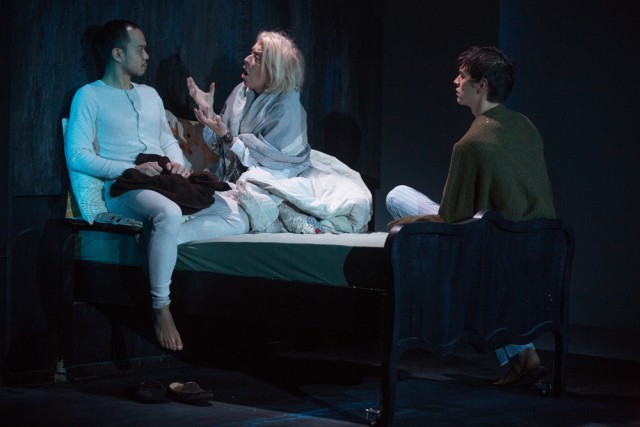
Claude (Jon Norman Schneider), Eleanor (Suzanne Bertish), and Dash (Devin Norik) try to make their dreams come true in Paris in Anton Dudley’s CITY OF
Peter Jay Sharp Theater
416 West 42nd St. between Ninth & Tenth Aves.
Daily through February 21, $10-$35
www.playwrightsrealm.org
Self-taught French artist and Customs agent Henri Rousseau never left Paris, but he often visited the city’s natural history museum, zoo, and botanical gardens, which influenced such famous paintings as his 1910 masterpiece, “The Dream,” in which a nude woman reclines on a sofa in the middle of a jungle. The painting serves as the jumping-off point of Anton Dudley’s second work for the Playwrights Realm, City of (following 2007’s Substitution, the Realm’s inaugural production). As the hundred-minute one-act opens, a young man named Claude (Jon Norman Schneider) is in MoMA, enraptured by “The Dream”; meanwhile, nearby, the tall, aristocratic Dash (Devin Norik), who turns out to be the wealthy owner of the work (now that his beloved mother has passed on), is enraptured by Claude. Soon the two are off to Paris, along with Cammie (Colby Minifie), who wants to sing on the stage of the Paris Opera House, and Eleanor (Suzanne Bertish), who is seeking out her dead father as she ventures into old age. Paris is represented by a pigeon with a sweet tooth (Cheryl Stern) and a gargoyle on the facade of the Cathedral of Notre-Dame (Steven Rattazzi, who also plays the ghost of Paul Verlaine and others). All of the main characters search for their dreams — or nightmares — as they make their way through a magical, haunted Paris. The play gets its name from how characters regularly are unable to finish descriptions of Paris, saying over and over again, “City of . . .” without filling in that last noun. Just as Claude, Dash, Cammie, and Eleanor can’t seem to quite put their finger on what makes Paris tick, Dudley and director Stephen Brackett (Buyer & Cellar) can’t seem to quite put their finger on what might make City of tick. Choppy dialogue has characters speaking on top of one another or sharing lines in unison as well as reading stage directions about themselves in the third person, confusing the action or reinforcing relationships to the point of overkill. Virtually everything is overstylized until it is understylized; the best scene in the play is Eleanor’s late soliloquy, passionately delivered by Royal Shakespeare Company veteran Bertish. Rousseau’s surreal painting can be interpreted many different ways by each viewer, deserving of extended attention; unfortunately, the same cannot be said for Dudley’s muddled theatrical homage.